Blog by Steve Laug
A fellow Vancouver Pipeman named Alex has been keeping me busy with working on the pipes he is picking up. He is selling quite a few of his pipes on the rebornpipes store right now so that he can change the direction of his collection. He is currently picking up a lot of interesting American and English made pipes. One of those is this Canadian that is engraved on the underside of the shank and reads as follows: Handmade Canadian by Bill Lator. It is a nice piece but has some unique features that are visible in the photos that follow. It had a Sterling Silver decorative band (no cracks or damage to the shank). The shank ahead of the band has a definite curve to it… to me it made the pipe interesting. There was also a cant to the bowl with the backside of the bowl more angled. The rim top has some damage that has been cleaned up and the backside of the rim is thinner than the rest of the bowl. The bowl is clean and quite pristine. The stem did not fit well in the shank and had a definite whistle when you drew air through it. 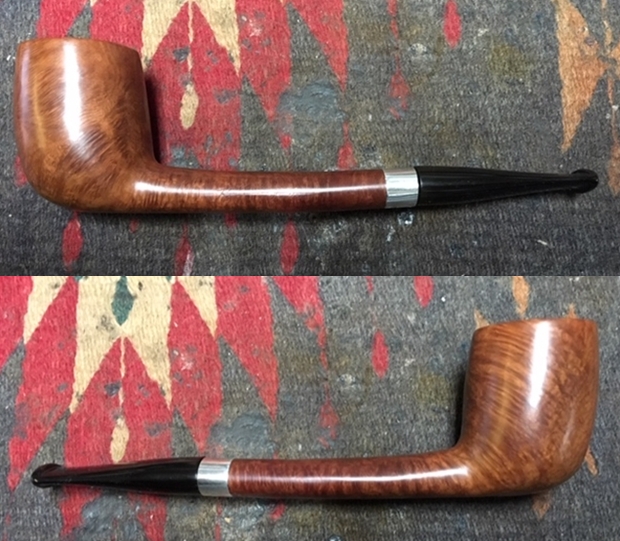
 I took some close-up photos of the rim to show the condition of the rim top and the inner and outer edge of the bowl. The rim top had some dents and damage to it and the inner edge was thinner at the back of the bowl. The outer edge had a few nicks and dents in it. The stem was in excellent condition though the fit of the stem to the band was off in that the stem circumference was bigger than that of the inside of the band keeping the stem from seating properly in the shank. The silver band is engraved Sterling Silver on the underside.
I took some close-up photos of the rim to show the condition of the rim top and the inner and outer edge of the bowl. The rim top had some dents and damage to it and the inner edge was thinner at the back of the bowl. The outer edge had a few nicks and dents in it. The stem was in excellent condition though the fit of the stem to the band was off in that the stem circumference was bigger than that of the inside of the band keeping the stem from seating properly in the shank. The silver band is engraved Sterling Silver on the underside. The engraving on the underside of the shank is shown in the photo below. It is also engraved on the left side of the shank with the name of the individual for whom the pipe had been made. It is worn but I can make out “Made For” and under that is the name Keith R. Westerberg (?) at least that is what it looks like. It is faintly etched but the first part is more readable than the last name.
The engraving on the underside of the shank is shown in the photo below. It is also engraved on the left side of the shank with the name of the individual for whom the pipe had been made. It is worn but I can make out “Made For” and under that is the name Keith R. Westerberg (?) at least that is what it looks like. It is faintly etched but the first part is more readable than the last name. When Alex dropped it off I asked him to do a bit of research on the brand and see what he could find out about the pipemaker and the brand. He said he would and over the next couple of days sent me several emails with information that he had found out about the pipe.
When Alex dropped it off I asked him to do a bit of research on the brand and see what he could find out about the pipemaker and the brand. He said he would and over the next couple of days sent me several emails with information that he had found out about the pipe.
The first email was the description given of the pipe on the SATX Pipes site – the company he purchased it from. They gave a pretty detailed description of the pipe and the stamping on the pipe. He included a photo of the pipe along with the description.
This is a very rare hand made Canadian by Bill Lator. In addition, it bears the customer’s name on it that it was commissioned for. Bill Lator was a pipe maker from Indiana who operated two small pipe shops with his family.
This particular Lator is in fine shape. Stem is shiny black and free from any chatter. Beautiful grain and color is offset by a sterling silver band. This is a non-filtered pipe. Pipe has been sanitized, polished and waxed, and comes ready to smoke. Pipe Dimensions: Length Overall: 6 1/8″ Height Overall: 1 3/4″ Width Overall: 1 1/4″ Chamber Width: 7/8″ Chamber Depth: 1 5/8″ Weight: 1.1 oz Alex added a personal note with the description and reflected that though the description says…it bears a customer’s name, but I didn’t notice that. All I saw was “Handmade Canadian by Bill Lator”.
Alex added a personal note with the description and reflected that though the description says…it bears a customer’s name, but I didn’t notice that. All I saw was “Handmade Canadian by Bill Lator”.
Alex also sent along picture of a Magazine cover showing …Bing with a BL Canadian on the cover of a magazine. He also included an excerpt from a local newspaper article about the Lators from 1976:
He also included an excerpt from a local newspaper article about the Lators from 1976:
Pipemaking is a family affair for the Bill Lator family. The family owns and operates “The Pipemaker,” 109 N. Broad. Father Bill, Sr. and all three sons, Paul, 28, Bill, Jr., 20 and Kurt, 14 have taken up the rare trade of pipemaking. According to Lator, there are only about 20 pipemakers in the United States. “And three of them are in Griffith,” he quipped. Lator said his pipe making started as a hobby, “a way to relax after a busy day as an executive.” Lator also began doing extensive research into pipe making going through a number of west coast libraries and learning everything he could. About a year ago, his friends started suggesting he open a pipe shop and after more urging by his son Paul, Lator moved to Griffith. The fame of his handmade briar pipes combined with the skills of his wife, Hellen, in blending pipe tobacco made the shop an instant success. Lator said his oldest son turns out artistic pipes, “he is the artist in the family-Son, Bill is the “perfectionist.” His creations have a machined perfection according to his father, “which appeals to certain customers.” The youngest, Kurt, is still an apprentice, learning the trade of pipemaking with the discards and making tampers. Mrs. Lator has gained a reputation as a master tobacco blender.
Alex sent a follow-up email and included a paragraph from Bill Lator’s obituary: “Bill was very artistic and in 1973 found he could make beautiful smoking pipes carved of briar. In 1975 he along with his 2 sons, Paul and Bill, opened The Pipemaker Pipe and Tobacco shop in Griffith, Indiana. He loved that shop and all the customers. He made a very successful business that lasted 13 years. In 1986 he decided it was time for him to retire…”
From this I know that the pipe came from Bill Lator’s Griffith, Indiana Shop – the Pipemaker Pipe and Tobacco Shop. It had been made between 1975 and 1986 when Bill retired.
Now it was time to address three specific issues that I saw with the pipe.
- There was a distinct whistle when you drew on the pipe to pull air from the bowl to the button.
- The stem did not seat well in the shank and there was a gap in between the end of the shank and the stem when it was in place.
- The bowl was slightly out of round and the back wall was thinner than the rest of the bowl.
I decided to deal with the whistle in the airway first. I took the stem off and drew air through the shank. It was a clean and open draw with no whistle. With that test I knew that the problem was not in the shank. I turned to the stem and blew air through the tenon and out the slot. The whistle was loud and distinct. I shined a light through the tenon so see if there were any obstructions on the walls of the airway. That is often the cause of the noise. There can be debris left behind by the drilling of the airway. I could not see anything from the tenon end. I shined the light in the slot end and there I found the issue. The slot was deep and T shaped rather than Y shaped. This made the air whistle as it was drawn into the slot. I used a flat and a round needle file to reshape the airway in the slot to a Y shape. In my experience this shape makes the transition of the air from the bowl to the mouth a straight smooth flow with no interruptions.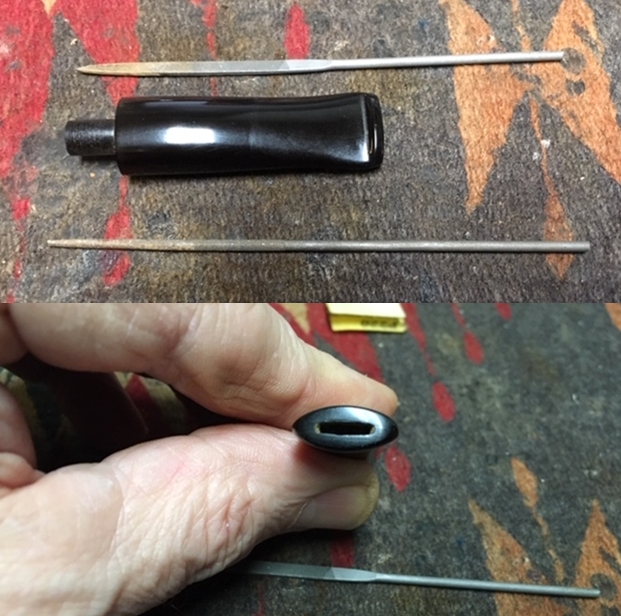 I cleaned up the slot with a folded piece of 220 grit sandpaper to smooth out the edges of and leave it free of debris.
I cleaned up the slot with a folded piece of 220 grit sandpaper to smooth out the edges of and leave it free of debris.
With the airway in the stem cleaned up and the whistling taken care of I turn ed to deal with the fit of the tenon in the shank. I used a sharp pen knife to carve a bevel in the shank face. The initial beveling was rough but when I tried the stem in the shank the fit was snug and there was no gap between the shank face and the face of the stem. I sanded the bevel with a folded piece of 220 grit sandpaper to smooth it out. The second photo shows the first sanding of the bevel. The third photo shows the final sanding of the bevel smoothing out rough edges. The final photo shows the finished bevel. I stained it to match the rest of the pipe using a Maple stain pen. The second issue was solved. Now it was time to address the third issue – the damage to the rim top and the bowl edges. After measuring the slop of the walls of the bowl on the front, the sides and back I could see that the thinness was primarily an issue with the top of the bowl. To deal with that I decided to lightly top the bowl with 220 grit sandpaper on a topping board. I removed the damage to the top of the rim and in doing so was able to reduce the thinness on the backside of the rim. I did not need to take much off of the rim top to effect this change and I was happy with the results.
Now it was time to address the third issue – the damage to the rim top and the bowl edges. After measuring the slop of the walls of the bowl on the front, the sides and back I could see that the thinness was primarily an issue with the top of the bowl. To deal with that I decided to lightly top the bowl with 220 grit sandpaper on a topping board. I removed the damage to the top of the rim and in doing so was able to reduce the thinness on the backside of the rim. I did not need to take much off of the rim top to effect this change and I was happy with the results.  I polished the rim top with micromesh sanding pads – wet sanding with 1500-2400 grit pads and dry sanding with 3200-12000 grit pads. I wiped the rim down with a damp cloth after each sanding pad. The rim top looked much better than when I started the process.
I polished the rim top with micromesh sanding pads – wet sanding with 1500-2400 grit pads and dry sanding with 3200-12000 grit pads. I wiped the rim down with a damp cloth after each sanding pad. The rim top looked much better than when I started the process.
 I restained the rim top and edges with a Maple stain pen. I buffed the bowl and stem with Blue Diamond on the buffing wheel to polish the pipe and then gave it multiple coats of carnauba wax. I buffed it with a clean buffing pad to raise the shine and hand buffed it with soft microfibre cloth to deepen the shine. The photos of the finished pipe are shown below. It is finish and the whistle is gone, the stem fits better against the shank and the rim top looks significantly better. I look forward to hearing what Alex thinks of his Lator pipe now… it is a beauty.
I restained the rim top and edges with a Maple stain pen. I buffed the bowl and stem with Blue Diamond on the buffing wheel to polish the pipe and then gave it multiple coats of carnauba wax. I buffed it with a clean buffing pad to raise the shine and hand buffed it with soft microfibre cloth to deepen the shine. The photos of the finished pipe are shown below. It is finish and the whistle is gone, the stem fits better against the shank and the rim top looks significantly better. I look forward to hearing what Alex thinks of his Lator pipe now… it is a beauty.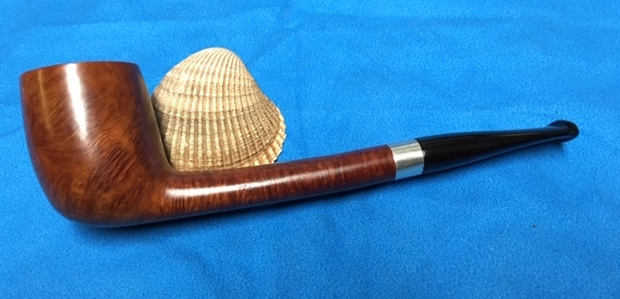
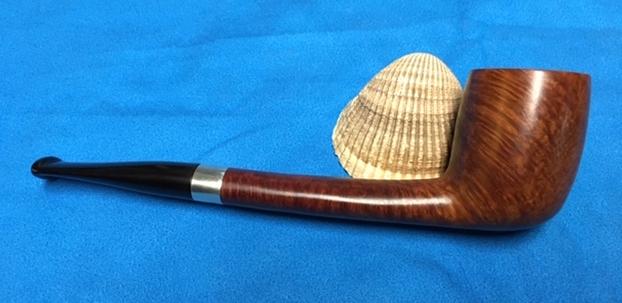
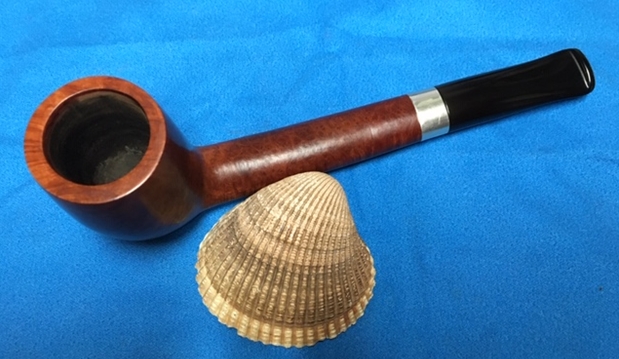

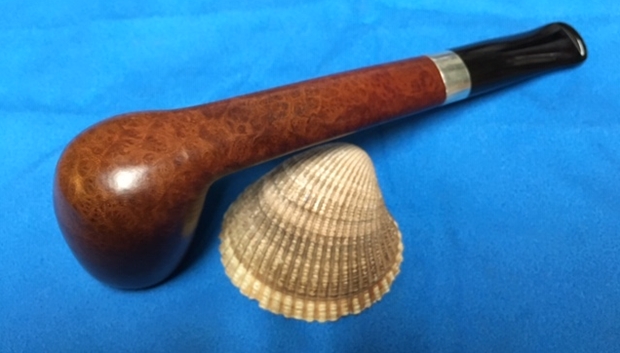


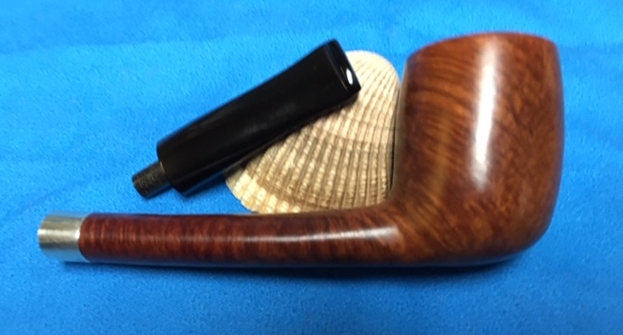
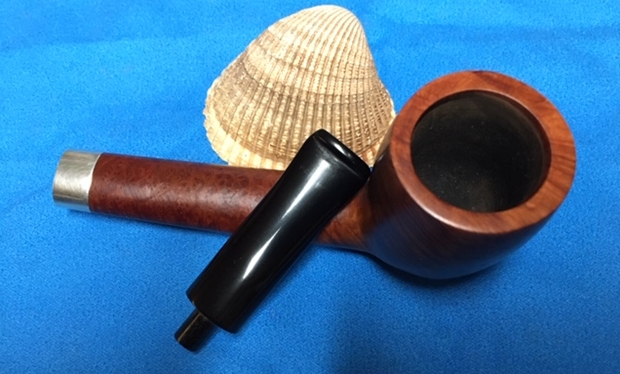


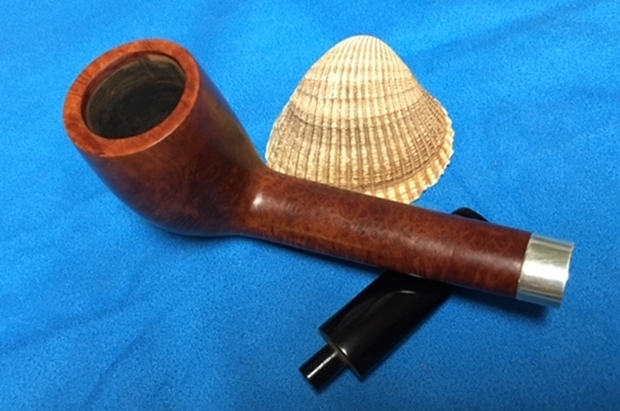
ADDENDUM
Yesterday (16 August 2019) Michele, Bill Lator’s daughter left an amazing comment on this blog about her Dad. I am highlighting that message because in the follow up to it she sent some photos of her Dad and the Pipe Shop in Griffith that I am including below.
I am Michele Lator-Murray, Bill Lator is my Dad. He is missed by all of us and so proud to see this article. I have forwarded it to our Mom. Our Brother Billy has passed also. Paul and Kurt are alive and well. My son has taken interest in his heritage and has a small collection of Dad’s Pipes.Thanks for the memories.
The photos include a picture of her Dad, Bill Lator by himself, with her Mom, a photo of the day Michele gave her son his first pipe that she found of her Dad’s online, the Pipemaker Pipe and Tobacco Shop advertisement from a Purdue Student paper and the backside of a book of matches.
Thanks so much Michele for send us these photos. It is always great to have a photo of the pipe man himself and some of the memorabilia.






